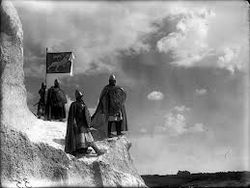A MULTI-MEDIA PROJECT BY MAIA STAM
FURTHER ITERATIONS OF GESAMTKUNSTWERK
 ValhallaImage of gods crossing the rainbow bridge to Valhalla in Wagner's "Das Rheingold." Image from opera news.com |  Alexander NevskyImage from Sergei Eisenstein's "Alexander Nevsky." Image from nysun.com |  Kabuki TheaterImage from memphisflyer.com |
|---|---|---|
 Swan LakeImage from The Imperial Russian Ballet Company's Swan Lake. Image from russianballet.com.au |  The Yellow SoundImage from Target Margin Theater's restaging of Wassily Kandinsky's "Der Gelbe Klang." Image from targetmargin.org |  Falling WaterFrank Lloyd Wright's Fallingwater home in Stewart Township, Pennsylvania. Image from fallingwater.org |
Anthony Tatlow approaches the theory of Gesamtkunstwerk with a perspective on drama in theater and film. In his essay, “Gesamtkunstwerk,” Tatlow begins by reviewing ancient Japanese theater, such as Kabuki and Noh, and its influence on the nineteenth-century theater actors, writers, and directors who shaped the definition and practice of Gesamtkunstwerk after Wagner. The “rhythmical movement and rhythmical colorism" of Kabuki and the “actor as part of choreographic design” in Noh theater made these forms obvious examples of Gesamtkunstwerk, though they appeared well before Wagner’s time (p. 172). These works had a significant impact on Fuchs, Meyerhold, and Eisenstein, all early 20th-century artists who shaped theater and Gesamtkunstwerk in their time by experimenting with new media and heightened drama in stage and screen productions. Tatlow contrasts these deeply integrated theatrical works with that of German poet and playwright Bertolt Brecht. Tatlow explains, “[Sergei] Eisenstein speaks of synthesis, while Brecht stresses the initial act of separation. The intention is the same: to break the power of the ‘unified collective re-experience.’” (p. 173).
Tatlow’s main point is that, while Gesamtkunstwerk was, and is, often associated with revolution and manipulation of power dynamics, a work cannot be judged based purely upon this criteria. Tatlow claims that Brecht’s plays, for example, cannot be considered Gesamtkunstwerk because of their “incompatible aesthetic and political intentions.” A true “total work of art” in a contemporary setting must embrace social and political intentions within its aesthetic, not beside or as a result of it. Tatlow mentions W.B. Yeats’ comment that the goal of Noh theater is to “make strange events credible,” responding that he disagrees. Instead, Tatlow argues, a true work of Gesamtkunstwerk should “make all-too-credible events strange” in order to draw the socio-political implications of such events into question.
Simon Shaw-Miller’s Visible Deeds of Music (2002) details the work of artists from ancient Greece through the 20th century, all striving to find new modes of expression by unifying the arts. Rather than present a specific theory or philosophy about art and music, Shaw-Miller adopts a case-study style, examining modernity in art and music through the works of specific artists throughout history. Through these cases the lineage of art is revealed - growing from a single unified form to a number of autonomous pieces. Shaw-Miller’s approach, while focusing on theater and visual art, highlights a number of connections between dance and Gesamtkunstwerk.
The musical scores and dramatic settings of the dramatic Russian ballets of the early twentieth century brought dance out of elite social culture and into a new, synthesized form, much like the great dramatic operas. Shaw-Miller describes this style of ballet as a modern form of Gesamtkunstwerk, however he also introduces dissenters to this form of hybridity, such as Russian composer Alexander Scriabin. Scriabin and his peers thought that the concert stage separated the audience from the drama, and called instead for a natural setting to create a truly holistic and transcendent artwork (p. 61). Scriabin argued that ballets and romantic operas failed to immerse their audiences in the action as the outdoor/amphitheater productions of ancient Greece had, and thus removed themselves even further from the unified experience that the Greeks had mastered. This school of thought gave birth to the modern era, in which artists of all backgrounds took their work out of a formal setting and experimented with natural light, color, composition, movement, and other mediums.
A primary example of such a modern work is Wassily Kandinsky’s 1912 stage piece, Der Gelbe Klang, or “The Yellow Sound.” Rooted in theories of color and sensation, the one-act dramatic work has no narrative, but moves through a series of images created by the movement of lighting and characters on the stage, all set to music by Kandinsky’s friend Alfred Schnittke (Von Haken, B). While there is very little dialogue in the work, Kandinsky wrote extensive notes for the show, including notes on lighting and color, costumes, and the general atmosphere of each section. This and other “color-tone dramas” by Kandinsky incited a movement of experimental theater, most notably in Germany. During this same period, modern visual artists were experimenting with new ways of interpreting their own form. Like Kandinsky, modern artists such as Vincent van Gogh, Paul Cézanne, and Georges Seurat found techniques in which the drama of their work was enhanced through manipulation of color and line. These artist laid the foundations for cubism and expressionism, in which artists broke down shape and line to simpler forms, believing that this could bring out a new interpretation of the drama of everyday life.
In an interpretation mirroring the ancient greek unification of life and art, architecture adopted Gesamtkunstwerk in the early twentieth century. Architects like Frank Lloyd Wright, Walter Gropius, and Ludwig Mies van der Rohe sought to design homes and buildings that combined the natural beauty of the earth with the functionality of modern architecture. These architects designed every aspect of a home from the foundation to the furniture, all in the name of a unified artistic experience so immersive that one could actually live in it. Though far removed from Wagner’s combination of music and drama, this combination of nature, tools, and everyday life created a new interpretation of Gesamtkunstwerk for modern times.